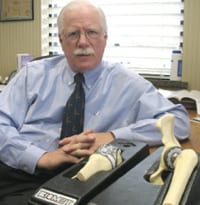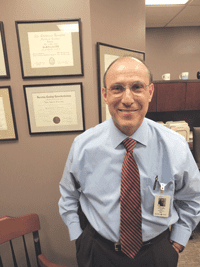New Lease on Life Joint Replacement Makes Significant Strides
Total joint replacement has long been considered a surgery for older, not younger, people — but not too old.
The rules, however, are changing.
“It’s mainly for arthritis, and arthritis is an age-related condition; most patients have been in their middle-aged years, some of them elderly,” said Dr. Henry Drinker, an orthopedic surgeon at Hampshire Orthopedics & Sports in Hatfield. “But more and more, we’re treating a younger patient population, due to a host of factors, including an increased emphasis on athletics and physical fitness, which has produced a lot of arthritic knees in younger people.”
Dr. Robert Krushell, medical director of the Hip and Knee Replacement Program at Baystate Medical Center, said the age of likely candidates for joint replacement has expanded on both sides of the spectrum.
“It’s common to see people coming into the office in their 50s, and sometimes younger than that, who need hip or knee replacement. And with the technology we have today, we’re much more comfortable offering it to people in that age range because it will last longer,” he said.
Meanwhile, “joint replacement has become much more common in people in their 80s,” he added. “I think that’s related to the fact that people are living longer, and they are staying otherwise healthy and more active. It’s common to see people coming in the office in their early to mid-80s, or older, in pretty good shape; they’re pretty robust and, if it weren’t for the arthritic joint, would be living very active lives.”
Those two trends point to one unmistakable fact: joint replacement is a very healthy field in which to practice today, with about 350,000 total knee replacements and close to 200,000 hip replacements being performed every year in the U.S., Drinker said. “And it’s on an exponential rise, partly because of Baby Boomers coming of age and experiencing arthritic joints.”
And that trend — both locally and around the country — is projected to continue over the next two decades, said Krushell. “Current projections say that the number of people getting hip replacements per year will double 10 years from now, and knee replacements will triple.”
Fortunately, doctors say, the technology that enables total joint replacement has improved, and the materials used have become more durable, to the point where the risk of complications has become much less for older patients, and artificial joints last much longer in people who undergo the procedure at a young age.
“There has always been a big concern about taking a damaged hip or knee in a young person and replacing it,” Drinker said. “You were pretty much guaranteed that the procedure would have to be done again in 15 or 20 years, or less, and redo procedures are much more invasive and much more destructive. So evolutions in the field have made it possible to bring this to a greater number of patients with joint problems.”
This month, HCN takes a look inside the changing world of total joint replacement and the advances that have made the surgery safer, and the results longer-lasting, just as more and more Americans of all ages are clamoring for it.
Hip Knee Hooray
The practice of joint replacement can, and does, encompass shoulders, elbows, wrists, and hands, but the vast majority of cases involve hips and knees.
The procedure is essentially what it sounds like: removing a damaged joint and replacing it with an artificial one, usually made from plastic or metal. The materials may be cemented into place, or not cemented and instead designed for the bones to grow into the prosthesis; the latter tends to have a longer recovery time, but also lasts longer in the long run, often making it a better option for younger people.
Dr. Khalid “Kelly” Instrum, an orthopedic surgeon with Holyoke Medical Center, said patients, along with their doctors, make the decision to undergo total joint replacement based partly on how their arthritis or other condition affects their ability to partake in day-to-day activities.
“For a younger person, that might be their athletic ability, while for an older person it may be the ability to take a walk with their spouse. Joint surgery is purely elective, and it depends on how it affects them. We never tell people they have to have it; it doesn’t save their life, but what we do does improve their life. As long as someone is healthy enough to go through surgery, it is pain-relieving, and something that gives people their lives back.”
In recent years, Krushell noted, new bearing surfaces have been developed that wear much more slowly and withstand much more activity without excessive wear, increasing the projected lifespan of these implants. The cementless option is particularly exciting, he said.
“There’s no longer any glue to loosen over time. These bonds that the bone makes onto the implant seem extremely durable; we almost never see these hip implants loosen. It’s a radical change, and we’re hopeful that some of these implants will be bonded to the bone forever.
“In the area of knee replacements,” he continued, “we’ve seen similar improvements in the area of bearing materials, and we’re just starting to delve into using knee replacements that also don’t need bone cement in the hope that, just like hip replacements, we’ll find that knee replacements get more permanent bonding. That’s pretty new, cutting-edge technology for knee replacement that’s not being used much around the country, but it’s starting to slowly gain traction.”
Instrum has also observed a series of evolutions in the field, from new materials to the increasing use of minimally invasive surgical techniques.
“We can make smaller incisions without cutting the muscles, so the length of stay after surgery is reduced,” he said. “It allows people to get up and get going quicker. With the techniques we used to use, people had to watch how they bent over after hip replacement, but with modern techniques, often they don’t have to worry about those types of problems anymore.”
Drinker noted that, with minimally invasive methods, “the ease of recovery may be affected, and the pain to the patient is maybe less. Scars are smaller, and blood loss is lower.”
Still, he said, such surgeries are not standard across the discipline. “They have a steep learning curve and are fraught with complications. There will always be some surgeons who use these techniques, but I’m not sure they’ll be universally recognized everywhere.”
In addition to the emergence of minimally invasive surgery, allowing patients to recover more quickly, Krushell said, “another thing that’s been very helpful is some of the newest techniques in post-operative pain control. It hurts a lot during the first few days after surgery, but if you have good pain control, it can be a lot easier to get up and out of bed, do your therapy, and get good motion in your joint.”
Progress Around the Bend
Drinker, who is affiliated with Cooley Dickinson Hospital, touted CDH’s dedicated Joint Replacement Center as the wave of the future in this field.
“What we have here at Cooley Dickinson represents the state of the art,” he said of the 12-year-old department; before that, joint-replacement patients were part of the general hospital population. “In this segregated physical space in the hospital, those patients are the only patients on the floor. It’s almost a quarantined unit in the hospital, and it’s had a big impact on patient experience and outcomes. I believe it’s the only dedicated total joint service in New England.”
The primary advantage, he said, is that all nurses and physical therapists on the floor are trained in the subspecialty of joint replacement. Not only is the patient-nurse ratio small, but patients can expect a certain consistency of care since they aren’t being treated by nurses rotating in from other units.
“What’s really special about the joint center is that we have a specialized program for joint-replacement patients. We have a separate unit, and we have our own exercise room right here in our unit, and we have a pathway of care specifically for joint patients,” said Anne Ridabock, clinical coordinator of the center. “We try to do most of joint surgeries on Mondays, then 99{06cf2b9696b159f874511d23dbc893eb1ac83014175ed30550cfff22781411e5} of the time they’re discharged on Thursday. And they can follow this path together: group exercise every day, as well as individual exercises tailored to them.
“Our staff here is just so well-versed in caring for joint patients; they’ve undergone specialized training and have years of experience as well, and that makes for a very smooth, very efficient process,” she continued. ”The patients are continually telling us, ‘you work as a team here; you anticipate what we need.’ It’s an amazingly smooth operation.”
The setup also helps to control complications, particularly infections, Drinker said, noting that the national infection rate for joint-replacement surgery is about 1.5{06cf2b9696b159f874511d23dbc893eb1ac83014175ed30550cfff22781411e5}, while Cooley Dickinson’s is around 0.6{06cf2b9696b159f874511d23dbc893eb1ac83014175ed30550cfff22781411e5}. “One reason is that, by having a quarantined floor, these patients are not subject to hospital-borne infections to the extent they would be on a general medical floor.”
Ridabock said the unit’s focus on “going the extra mile” in infection control includes the hospital’s recent adoption of a cutting-edge system that disinfects patient rooms using ultraviolet light. “And all joint-replacement patients have to be cleared of infectious processes, because an infection in the joint is a real problem. Just having a specialized unit keeps complications low, patient satisfaction high, and really aggressive physical therapy possible.”
Having a specially trained nursing staff also cuts down on the incidence of dislocation in the first few days following the procedure, Drinker added. “The occurrence of a dislocation in the first few days after this operation is often related to nursing care and patient education.” Meanwhile, he added, group-therapy sessions allow patients to share each other’s apprehensions and triumphs.
One Step at a Time
Doctors share in such triumphs, too, and Instrum said it’s gratifying to see people able to do more things, whether it’s a young or middle-aged patient or a Baby Boomer who — like many members of that generation — intend to stay vigorous well into their retirement years. “Obviously it’s good for their general health and helps them be active.”
Krushell cited a patient who went on to achieve long-time goals, including visiting the Grand Canyon and the Great Wall of China. “She never thought she’d be able to do stuff like that. Then a lot of patients just say they want to go for walks with a parent or grandparent.”
Helping them get there, he said, is personally satisfying.
“I feel amazingly blessed to be in my field. In my normal day in the office, I see people starting to get their lives back again. People commonly say this is the best thing they’ve ever done, so it is very gratifying to see people who couldn’t get around before surgery get back to their lives again.”


